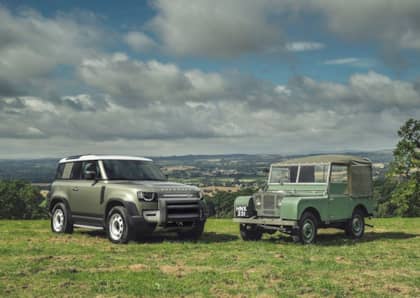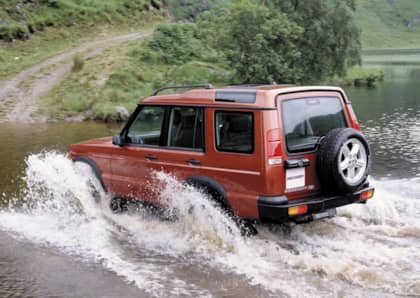The Range Rover Classic Introduced Land Rover Luxury To American Audiences
Land Rover's journey from builder of basic go-anywhere 4x4s to purveyors of high-end luxury SUVs hinges on a single model: the original Range Rover. Introduced in 1970, the vehicle represented the culmination of changes to the burgeoning sport-utility market over the previous two decades.

The Rover division of British Leyland had become convinced that not only did residents of the far-flung former British colonies require transportation that was comfortable and capable in areas where asphalt was often non-existent, but that Americans, too, were seeking ever-better off-road rigs as part of a blossoming recreational vehicle market. As a result, the Range Rover was a step up over previous Land Rover offerings in terms of creature comforts, while compromising not at all on its prowess once the going got tough.
100 Unstoppable Inches
The original Range Rover was advertised as a 'Four-In-One' car, combining luxury, performance, estate (wagon) levels of space and cross-country comfort. Indeed, the internal program that led to the Range Rover's development had been aimed at creating a '100-inch Station Wagon,' referring to the wheelbase of the vehicle.

When it first hit showrooms the Rover SUV offered permanent four-wheel drive, a coil-spring suspension system, and a two-door layout with ample cargo room at the rear. Power was sourced from a 3.5-liter aluminum V8 good for just over 130 ponies and 185 lb-ft of torque, and shifted via a four-speed manual gearbox. Four-wheel disc brakes were offered, the body-on-frame design made use of aluminum body panels to help reduce weight, and the Range Rover boasted a top speed of 95-mph.

British Leyland set out to drum up interest in its new sport-utility right away by creating the British Trans-Americas Expedition, which departed from Anchorage, Alaska in December of 1971 and arrived at the tip of South America roughly six months later. This was the first motorized overland journey from one end of the Americas to the other, and it included a grueling three month slog through the Darien Gap, a roadless stretch of jungle that cuts the Pan-American Highway in two. Promotional efforts also reached in the complete opposite direction by having the truck displayed as a piece of 'modern sculpture' at the Louvre in Paris.
A Winner From The Start
Response to the Range Rover was overwhelmingly positive. The automotive media had a field day comparing the latest 4x4 to the current crop of offerings from Toyota (Land Cruiser), Jeep (Wagoneer), and Detroit (Blazer, Bronco, Ramcharger), and the vehicle frequently emerged the victor.

By 1981, the Range Rover had gained a four-door model, and was enjoying major success in almost every global market—except for one. Despite having been designed to appeal to American buyers, shaky finances and the inability to meet federal regulations had kept Range Rover out of the United States for the entire 1970s. Eventually a series of unofficial 'grey market' importers began to spread the gospel for the brand, and by the middle of the 1980s the Range Rover (which was now being produced by Land Rover rather than British Leyland) was a must-have yuppie accessory for the Martha's Vineyard set, joining luminaries like the Jeep Grand Wagoneer.

The groundswell of interest in the vehicle convinced Land Rover to establish a U.S. beachhead in 1987 and begin legal importation. The four-door model found in dealerships maintained the same drivetrain as its original two-door sibling, upgraded to 150 hp and a four-speed automatic transmission sourced from ZF. A mightier 178hp, 3.9L V9 would arrive a few years later, followed by an air suspension system in 1992. There was also the availability of a somewhat longer wheelbase edition with improved interior room.
In a somewhat strange twist, a new model, the Discovery, was developed a couple of years later by adding new body work to what was essentially the Range Rover drivetrain and chassis.
Worth The Stress
In 1994 the next-generation Range Rover would finally deliver meaningful upgrades in terms of power, features, and styling, and help cement the vehicle's position among luxury vehicle buyers for the foreseeable future. The previous Ranger Rover would be dubbed the 'Classic,' and continue to be built briefly alongside its new companion. The term would gradually come to encompass the entire run of vehicles, regardless of when they were constructed.

It's impossible to overstate the Range Rover's impact on British Leyland (later Rover Group)'s fortunes. The SUV's reputation around the world was such that it became a never-ending piggy bank for its various corporate masters, and even today its provides the lion's share of sales from Jaguar Land Rover Limited, which operates under the auspices of India's Tata.

Owning a classic Classic is, like all Land Rover passions, a bit of a challenge. Known to rust nearly everywhere other than its aluminum skin (thanks to a reputation for water infiltration), facing the same electrical challenges common to many British cars of its vintage, and frequently sitting on dead airbags, the care and feeding of a Range Rover is not an inexpensive undertaking.

Although Land Rover itself tried its hand at selling tip-to-tail Range Rover restorations at the staggering cost of $170,000 each in 2017, you can easily pick up a driver for around $10k—which might seem cheap, until you start looking down the barrel of an expert repair shop's invoicing system. That being said, the pricing tide on classic trucks and SUVs has been steadily on the rise, and the Range Rover Classic seems particularly poised to benefit from increased collector attention.
Curious about other classic two-door SUVs? Check out our round-up of the best, and worst, two-door off-roaders.











